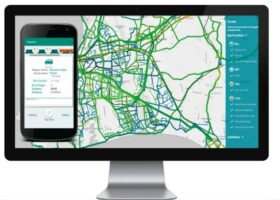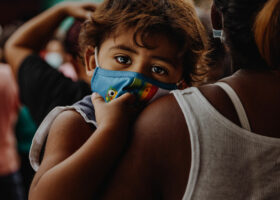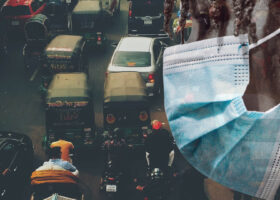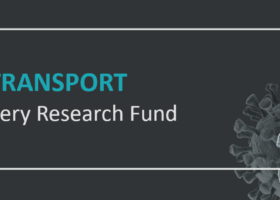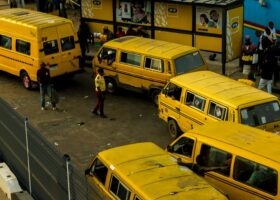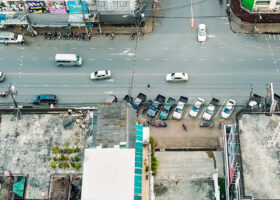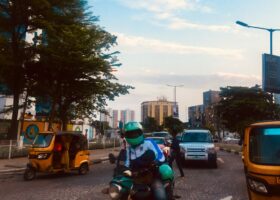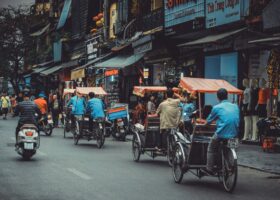Overview
In response to the surging COVID-19 infections, Nepal went into a complete lockdown from 24th March to 20th July 2020. Public transportation resumed service from 23rd July 2020, with limited guidelines issued by the Department of Transport Management (DOTM). But the service was halted for a second time from 20th August to 9th September 2020. From 10th September, only half the vehicles could operate as the government issued an odd-even rule, which allowed odd number plates to ply on odd dates and even number plates to ply on even dates.
Due to the two lockdowns and the odd-even rule that followed, the sector has suffered huge financial losses. Companies and owner-operators are pressured by revenue losses, loan repayments, and underutilised assets; drivers and operators have lost jobs; and the entire sector continues to suffer from a prolonged drop in commuter demand.
There are significant concerns from an epidemiological angle as well. Bus, mini-bus, micro-bus, tempo (threewheelers), taxi, and motorcycle taxis are the dominant vehicle types in Nepal. The passenger carrying capacity of buses ranges from 26 to 55 depending on its size while the capacity of micro bus, tempo, taxi and motorcycle taxi are 13, 11, 4, and 1 respectively. Each vehicle has different boarding and un-boarding systems, seat arrangements, ventilation and air-circulation systems, and length of routes. All of these factors make each vehicle represent different levels of epidemiological risks, but neither the government nor the public is aware of the relative risk exposure in choosing different types of vehicles available in the mix. This study fills that crucial gap.
Publications with the same themes
Publications with the same study countries
Related news & events
News
Blog
News
News
News
Blog
News
Blog
PDF content (text-only)
i COVID-19 IMPACT ON PUBLIC TRANSPORT AND SAFE REVIVAL: PRACTICES AND INNOVATIONS A policy brief on reducing the epidemiological risks and economic losses in the public transportation sector in Nepal COVID-19 Impact on Public Transport and Safe Revival: Practices and Innovations March 2021 HVT029.L3M146 – Nepal Institute for Urban and Regional Studies (NIURS) 2 COVID-19 IMPACT ON PUBLIC TRANSPORT AND SAFE REVIVAL: PRACTICES AND INNOVATIONS This research was funded by UKAID through the UK Foreign, Commonwealth & Development Office under the High Volume Transport Applied Research Programme, managed by IMC Worldwide. The views expressed in this Policy Brief are those of the authors and do not necessarily reflect the UK government’s official policies, nor those of any individuals and organisations referred to in this policy guidance note. IMC Worldwide Ltd, the HVT Programme and the UK government shall not assume any responsibility for the results of works based on the use of this Policy Brief. Users accept this publication is a guidance document only. Users accept that they need to take their own technical and legal advice before issuing Agreements, Terms and Conditions and other legally binding documentation related to implementing any recommendations. The data collection, consultation and other research processes used to create this policy brief have been subject to the necessary data protection regulations and requirements operating in the relevant countries where the research was conducted. All due diligence has been undertaken to ensure that data sources and statistics quoted have been appropriately aggregated so as to remain anonymous and not to identify any individual. Personal data has only been processed or used for specific and legitimate purposes. Reference No. HVT029.L3M146 Lead Organisation/ Consultant Nepal Institute for Urban and Regional Studies (NIURS) Partner Organisation(s)/ Consultant(s) Title COVID-19 Impact on Public Transport and Safe Revival: Practices and Innovations Type of document Policy Brief Theme Urban transport Sub-theme COVID-19 Author(s) Dr. Jagadish C. Pokharel, Kishore Thapa, Dr. Sagar Prasai, Dr. Prastuti Sharma, Dr. Ajay C. Lal, Ranjan Bhatta, Richa Dhungana, Ankit Karna Lead contact Dr. Jagadish C. Pokharel Geographical Location(s) Nepal Keywords Public transport, COVID-19, Nepal, human mobility, pandemic Funding FCDO/ UKAid 3 COVID-19 IMPACT ON PUBLIC TRANSPORT AND SAFE REVIVAL: PRACTICES AND INNOVATIONS BACKGROUND In response to the surging COVID-19 infections, Nepal went into a complete lockdown from 24th March to 20th July 2020. Public transportation resumed service from 23rd July 2020, with limited guidelines issued by the Department of Transport Management (DOTM). But the service was halted for a second time from 20th August to 9th September 2020. From 10th September, only half the vehicles could operate as the government issued an odd-even rule, which allowed odd number plates to ply on odd dates and even number plates to ply on even dates. Due to the two lockdowns and the odd-even rule that followed, the sector has suffered huge financial losses. Companies and owner-operators are pressured by revenue losses, loan repayments, and underutilised assets; drivers and operators have lost jobs; and the entire sector continues to suffer from a prolonged drop in commuter demand. There are significant concerns from an epidemiological angle as well. Bus, mini-bus, micro-bus, tempo (threewheelers), taxi, and motorcycle taxis are the dominant vehicle types in Nepal. The passenger carrying capacity of buses ranges from 26 to 55 depending on its size while the capacity of micro bus, tempo, taxi and motorcycle taxi are 13, 11, 4, and 1 respectively. Each vehicle has different boarding and un-boarding systems, seat arrangements, ventilation and air-circulation systems, and length of routes. All of these factors make each vehicle represent different levels of epidemiological risks, but neither the government nor the public is aware of the relative risk exposure in choosing different types of vehicles available in the mix. This study fills that crucial gap. Data and Methodology A set of primary data was collected through a survey, supplemented by key informant interviews (KIIs) with sectoral experts, epidemiologists, government agencies, public vehicle associations, and private sector vehicle operators. The survey of vehicle-owners and operators’ generated data on the financial health of public transportation companies, the impact on the livelihoods of the workers, types of assistance programs desired by the operators, the scale of the economic assistance required, financial coping strategies of the operators during the lockdown and other relevant information on the impact of the lockdowns. The survey of passengers generated data on passenger’s choice of transport mode and frequency of travel before and after COVID-19, journey time, safety measures in the vehicle, and passenger behaviour in relation to the recommended precautionary measures. Secondary data was drawn from the Central Bureau of Statistics (CBS), financial institutions, and regulatory agencies including Ministry of Physical Infrastructures and Transport (MOPIT) and Department of Transport Management (DOTM) to determine the types and number of vehicles operating in the sector, the economic output of the sector, the total employment generated by the sector, the total population served by the sector and other macro-level data to describe broad sectoral dynamics of public transportation system in Nepal. In addition, we reviewed documents, reports, research articles and guidelines issued by national and international public health regulators on the nature of the virus, its modes of transmission, international practices in attempt to safe re-opening of public transportation and the effectiveness of such measures. Major Findings a. Fleet size before and after lockdown It is our current estimate that the effective fleet size of the public transport sector in Kathmandu is at around 55 percent of the pre-lockdown number. This indicates that the sector continues to suffer from underutilisation of assets even as it struggles to cope with the revenue losses of the lockdown period. b. Estimating revenue losses in the sector Our survey shows that only 37.5% of commuters currently prefer using public transport. The reduced commuter demand and fleet size has resulted in reduced revenue for the public transport operators. When calculated on a daily basis (counting only those vehicles that are plying) the revenue loss amounts to little under 30% for 4 COVID-19 IMPACT ON PUBLIC TRANSPORT AND SAFE REVIVAL: PRACTICES AND INNOVATIONS buses, around 42% for taxis and micro-buses, and just over 36 % for tempos. The only vehicle type that shows a trendline in the other direction is the motorbike taxi (MBT). MBTs are not regulated in Nepal but have gained in popularity rather rapidly. c. Job losses in the public transport sector The National Planning Commission of Nepal in 2020 has estimated a total number of job losses of 1.56 million due to COVID-19 pandemic. In the transportation sector 315,000 people may have lost their job. Similarly, there has been a significant drop in vehicle registration which is likely to reduce the job in this sector. While we are unable to put a currency figure on the impact of the pandemic on the public transportation sector in Nepal solely on the basis of our survey, we are able to suggest that the sector may have shrunk in value by approximately 30 percent at this point of time. With the easing of the lockdown two months ago and gradual reopening of other sectors of the economy including aviation, domestic tourism, manufacturing, and construction, the sector is gradually growing back. The financial upheaval that individual companies have gone through will leave some of the entrepreneurs in the sector bankrupt and unable to utilise their assets. This may drag the sector’s recovery further. d. Public transport entrepreneurs’ demands on the government The Federation of Nepali National Transport Entrepreneurs (FNNTE) has put forth a list of demands with the government to revive the sector. It wants the government to bear the cost of all infection control measures that they are instructed to adopt, subsidise health insurance coverage, refinance loans at a subsidised rate, defer registration fees and local taxes, defer monthly loan servicing payments, and waive route permit fees. e. Government response to the transport sector demands For its part, the government has recognised the sector as one of the “most affected sectors” in its budget speech of FY 2020/21. In terms of addressing the demands of the entrepreneurs, no special treatment has been accorded to the sector. The entrepreneurs in this sector are eligible to apply for national low-interest refinancing facility through their respective banks; a total of USD 650 million has been allocated for this purpose. This is, however, not partial to the public transport sector, all firms operating in the country are eligible to apply. The government has also deferred registration fees and local taxes by a period of four months. f. Evaluating relative risks across vehicle types Awareness Levels The survey shows that only 25% of the bus and micro-bus operators and 15.69% of the tempo operators are aware of the government guidelines. On the other hand, 100% of the taxi and motorbike taxi operators reported that they were aware of the guidelines. Buses, micro-buses, and tempos are normally operated by larger companies; taxis and motor-cycle taxis tend to be operated by owner-operators. Disinfection Procedure The survey showed that most of the vehicles (69.2% of buses, 83.3% micro buses, 42.86% of tempos, 64.71% taxis) are sanitised with disinfectants, whereas 100 % of MBT operators sanitise with soap water. It shows that the disinfection of vehicles has not been followed as per the Government guidelines, which requires disinfecting seats and touched surfaces after each trip and prior to the dispatch from the parked garages. Most of the vehicle operators and staff reported sanitising their hands prior to the operation. Once on the driving seat, however, drivers find it difficult to find hand-washing facilities along the route. There is a shortage of water and public toilets for vehicle operators. Public hand washing stations put up by the local authorities are not convenient for drivers and helpers due to their locations. Provisioning temporary hand-washing stations at bus stops may be helpful here. Boarding and un-boarding practice From the field observations, it was found that passengers attempt to maintain a certain distance at stops, though standing in an orderly queue is not practised. But as the vehicle approaches, there is a crowding to board the vehicles. This phenomenon is observed in vehicles with fixed routes (Bus, Micro Bus and Taxi). One 5 COVID-19 IMPACT ON PUBLIC TRANSPORT AND SAFE REVIVAL: PRACTICES AND INNOVATIONS of the possible reasons behind this is the poorly managed vehicle stops that are not sufficiently spacious for passengers to stand in a queue while maintaining a safe distance. Masks were extensively used by the passengers as well as vehicle staff. It was mandatory for the passengers to wear a mask. Hundred percent of micro bus, tempo, taxi and motorbike taxi require their passengers to wear masks. Hand sanitisation and temperature checks prior to boarding was, however, not as common. The operators tend to be confident that passengers are taking necessary precautions to avoid infection. Seating Arrangements The seating arrangements are different across five vehicle types. Initially, the guidelines developed by DOTM required keeping alternate seats empty to maintain distance between the adjacent passengers. The compliance on this guideline should have been higher than what it is as there was no extra cost incurred in complying with this norm and the operators were allowed to charge double the fare from passengers while the restrictions were in place. Ventilation Various studies carried out in different parts of the world suggest that the risk of transmission is higher in closed, confined places with poor ventilation. The survey revealed that 94.2% of the bus operators and taxi operators who have attempted to increase internal ventilation did so by keeping the windows open all times. In microbuses and tempos, 100% reported that they keep their ventilation open all times as an attempt to minimise the risk of virus transmission. But, from field observation it has been found that the windows remained mostly closed in mornings and evenings and only partially opened during daytime. This is perhaps because the passengers themselves close the windows when it is cold or when the vehicle travels on dusty roads. Evaluating relative risks across vehicle types Based on our survey findings, interviews, and field observations, we have developed a matrix of relative exposure risks across the five different vehicle types. Each vehicle is compared along four factors: seating arrangement, ventilation, sanitisation, and boarding and un-boarding practices. We have rated each factor as high risk, medium risk or low risk. It has been found that motorbike taxis (MBTs) are the safest, followed by taxi cabs, and followed by tempos, bus, and microbus. The ratings—low, medium, and high—on a scale of 1-10 were assigned by 12 experts who participated in the exercise. The table below shows average ratings assigned by the expert panel based on their reading of the survey data. Comparing risk level with different vehicle type Vehicle/ Practices Seating Ventilation Sanitisation Boarding and Unboarding Bus (28.7) High Risk (8.3) Moderate Risk (6.1) High Risk (7.3) High Risk (7.0) Micro bus (31.7) High Risk (9.3) High Risk (8.0) High Risk (7.0) High Risk (7.4) Tempo (23.9) High Risk (8.0) Moderate Risk (5.1) Moderate Risk (5.0) Moderate Risk (5.8) Taxi (12.2) Moderate Risk (4.0) Low Risk (3.0) Low Risk (2.8) Low Risk (2.4) Motorbike taxi (4.5) Low Risk (2.5) Low Risk (0.3) Low Risk (1.0) Low Risk (0.7) Policy recommendations NIURS has assessed and illustrated the economic impact of COVID-19 infection control measures on the public transport sector in Kathmandu Valley. It has discussed the general exposure risk in the public transport system and evaluated the relative risk across five different vehicle types that are operated in Nepal. Reflecting on the findings, the following recommendations will be helpful in promoting and regulating the urban public transportation system in Nepal. 6 COVID-19 IMPACT ON PUBLIC TRANSPORT AND SAFE REVIVAL: PRACTICES AND INNOVATIONS Recommendations to the regulators: 1. Provide incentives to the public transport sector. The report shows that, depending on the vehicle type, about 15-55% percent of the vehicles are currently under-utilised in the sector. The more vehicles begin to ply on the routes, the faster the sector revives. While the government may not be able to provide large subsidies to the entire sector, small incentives such as reimbursing infection control costs to the operators or deferring fees and fines by additional six months or opening new routes or reducing taxes on diesel for a short period of time can potentially incentivise companies that are already thinking of re-entering the market. Over longer-term, however, subsidizing fossil fuel might inhibit market viability of cleaner options such as electric buses and subsidies should not be maintained beyond 3-6 months. Once more vehicles begin to operate, passenger load on individual vehicles decreases, commuters feel safer, and a virtuous cycle of growth will initiate. 2. Create funds for operationalizing the policies and guidelines. Costs of complying with the governmentissued guidelines is a major factor for non-compliance. An assessment of the compliance cost will reveal that the actual costs involved are not very high and the government can afford to set up a reimbursement system for all operators without taking on a large budgetary burden. If the government institutes a system of reimbursing this cost back to the operators, the compliance on mandated practices such as sanitisation will readily increase. 3. Create monitoring mechanisms to enforce guidelines and directives. As we have highlighted, the current enforcement mechanism is grossly inadequate for a city of 3.5 million people. These human resources dedicated to compliance checks needs to be increased. If the enforcement increases and brings about visible changes in the procedures (sanitising, distancing, ventilating, seating), public confidence on the safety measures will grow, commuter demand will grow, and the prospect of the sector reviving quickly will improve significantly. 4. Promote the type of vehicles that the public is willing to use. We have noted in the report that motorbike taxis (MBTs) are growing in popularity with demand almost doubling in the pandemic. This segment of the market has not been regulated or promoted by the government in any way. Since the public prefers this mode of transport, the government can get behind the public choice and promote the sector through new regulations and incentives at least during the pandemic. We understand that the government may not be able to accord a “preferential” treatment to a particular vehicle type under normal circumstances, but a temporary intervention and promotion is likely to help in controlling infection risks during a pandemic. 5. Create reliable database of public transport. It is quite extraordinary that we had to resort to extrapolative calculations and use various assumptions to arrive at a number that best estimated the current fleet size of the five types of public vehicles operating in Kathmandu. This kind of data should be ordinarily available with the regulators. Similarly, estimating total commuter demand prior to the start of the lockdown was equally onerous. The Government of Nepal should at least maintain fleet size, commuter volume, route volume, and peak demand data so that policies related to the sector can become more evidence-based. In addition, a crisis of this scale cannot be tackled without reliable, policy-relevant research. We strongly recommend that the government increases the data and research budget starting from the coming fiscal year and sustains the investments over time. Recommendations to the public transport operators: 1. Vehicle operators, not the government, form the perception of public safety. The vehicle operators have to do their part in instilling public confidence in the safety measures employed in the vehicles. The fastest way of reviving fallen commuter demand is by increasing public confidence in the public transport sector. 2. Scale-up innovations when they are identified. Both vehicle operators and passengers have individual initiatives to enhance their safety such as tempos using plexiglass dividers between the driver’s seat and the passenger cabin. Even when such measures are not epidemiologically proven to work, the optics matter. Such steps go a long way in building passenger and operator confidence in the system. 3. Prepare for markets that are opening up. The current slump in commuter demand is partially a function of some sectors of the economy not opening up. As the government prepares to open up additional activities, the transport entrepreneurs should prepare to deploy additional vehicles. If the supply-demand equation fails, overcrowding will follow, which will in turn erode public confidence in the transport system. Nepal Institute for Urban and Regional Studies (NIURS) Chakupat, Patandhoka, Lalitpur Nepal Tel: +977-1-5542410 Email: contact@niurs.org.np Web: www.niurs.org.np



